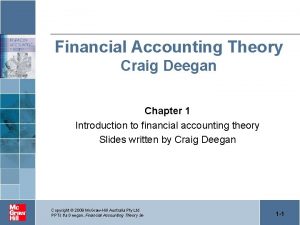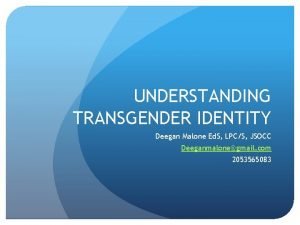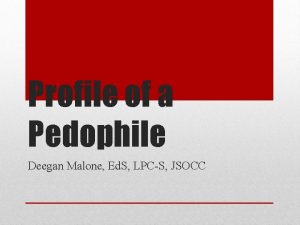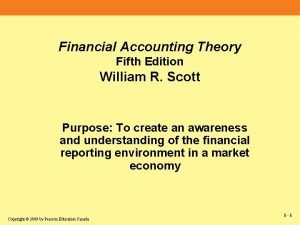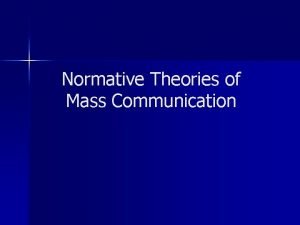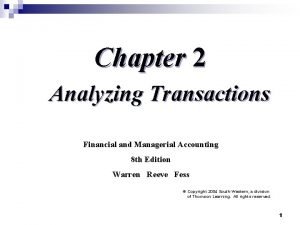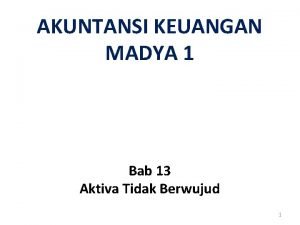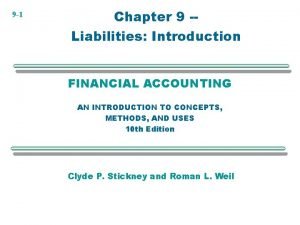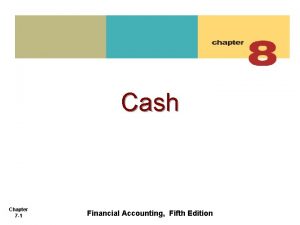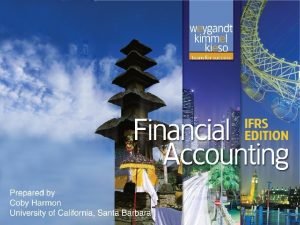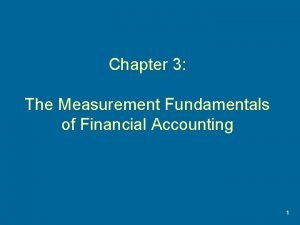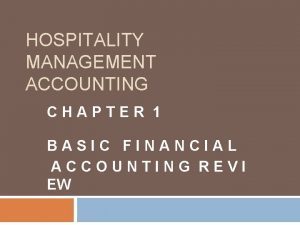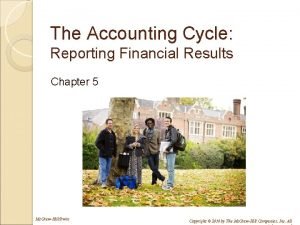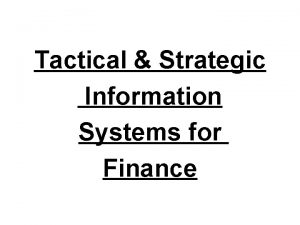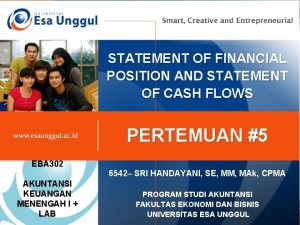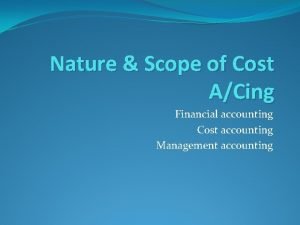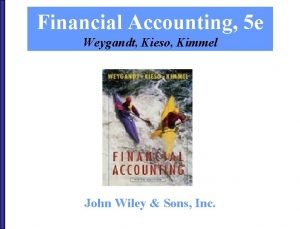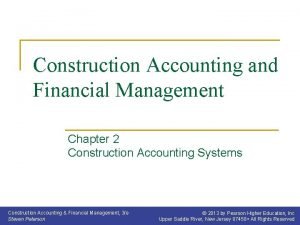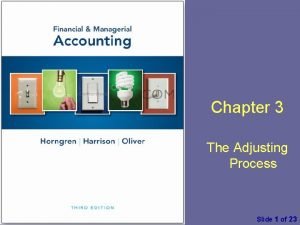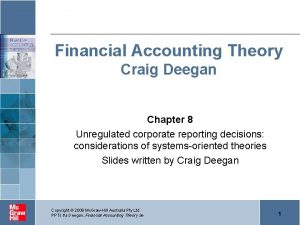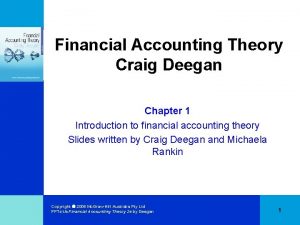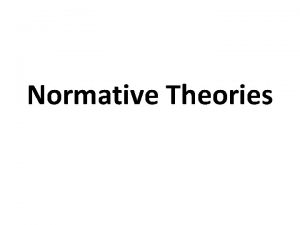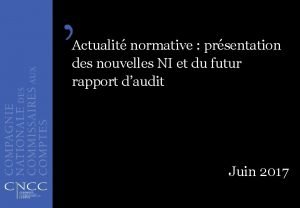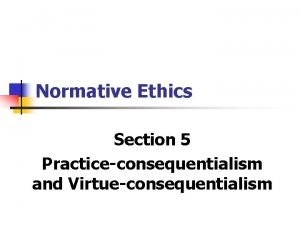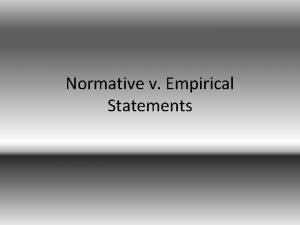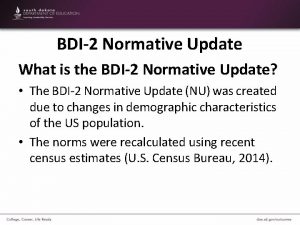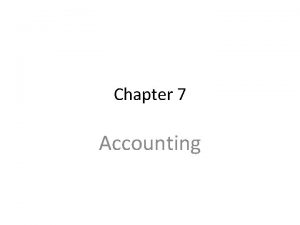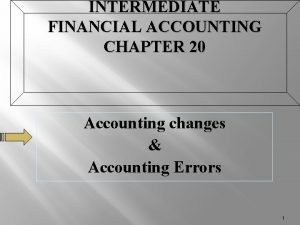Financial Accounting Theory Craig Deegan CHAPTER 6 Normative

































- Slides: 33

Financial Accounting Theory Craig Deegan CHAPTER 6 Normative theories of accounting: the case of conceptual framework projects Slides written by Craig Deegan Copyright © 2014 Mc. Graw-Hill Education (Australia) Pty Ltd PPTs to accompany Deegan, Financial Accounting Theory 4 e 6 -1

What is a conceptual framework? • A coherent system of interrelated objectives and fundamentals that is expected to lead to consistent standards and that prescribes the nature, function and limits of financial accounting and financial statements (Statement of Financial Accounting Concepts No. 1: Objectives of Financial Reporting by Business Enterprises 1978) • It attempts to provide a structured ‘theory’ of accounting • Conceptual frameworks provide prescription so they can be considered as normative theories of accounting Copyright © 2014 Mc. Graw-Hill Education (Australia) Pty Ltd PPTs to accompany Deegan, Financial Accounting Theory 4 e 6 -2

General purpose financial statements • The Conceptual Framework provides guidance for general purpose financial statements and not special purpose financial statements • GPFSs are financial statements – intended to meet the information needs of a variety of users. These users are usually unable to command the preparation of reports tailored so as to satisfy all of their specific information needs • By contrast, special purpose financial statements are provided to meet the information demands of a particular user, or group of users • GPFSs are financial statements that comply with accounting standards and other generally accepted accounting practices (GAAPs) Copyright © 2014 Mc. Graw-Hill Education (Australia) Pty Ltd PPTs to accompany Deegan, Financial Accounting Theory 4 e 6 -3

Who is required to prepare GPFSs? But which entities are expected to prepare general purpose financial statements? The answer is ……. Reporting entities are required to produce general purpose financial statements Okay, but what is a ‘reporting entity’? Copyright © 2014 Mc. Graw-Hill Education (Australia) Pty Ltd PPTs to accompany Deegan, Financial Accounting Theory 4 e 6 -4

Factors which can be indicative that an organisation is a reporting entity • Separation of management from those with an economic interest in the entity • The economic or political importance/influence of the entity to/on other parties • The financial characteristics of the entity Copyright © 2014 Mc. Graw-Hill Education (Australia) Pty Ltd PPTs to accompany Deegan, Financial Accounting Theory 4 e 6 -5

Users of general purpose financial statements (GPFSs) • In this regard, paragraph OB 5 of the IASB Conceptual Framework states: Many existing and potential investors, lenders and other creditors cannot require reporting entities to provide information directly to them and must rely on general purpose financial reports for much of the financial information they need. Consequently, they are the primary users to whom general purpose financial reports are directed continued Copyright © 2014 Mc. Graw-Hill Education (Australia) Pty Ltd PPTs to accompany Deegan, Financial Accounting Theory 4 e 6 -6

Level of expertise expected of financial report readers • Generally accepted that readers are expected to have some skill in financial accounting • IASB Conceptual Framework (para. QC 32) Financial reports are prepared for users who have a reasonable knowledge of business and economic activities and who review and analyse the information diligently. At times, even well-informed and diligent users may need to seek the aid of an adviser to understand information about complex economic phenomena. Copyright © 2014 Mc. Graw-Hill Education (Australia) Pty Ltd PPTs to accompany Deegan, Financial Accounting Theory 4 e 6 -7

Qualitative characteristics of financial information • To ensure financial information is useful for economic decision making, we need to consider the attributes or qualities that financial information should have • The IASB Conceptual Framework identifies: – Fundamental qualitative characteristics § relevance § faithful representation – Enhancing qualitative characteristics § § comparability verifiability timeliness understandability Copyright © 2014 Mc. Graw-Hill Education (Australia) Pty Ltd PPTs to accompany Deegan, Financial Accounting Theory 4 e 6 -8

Fundamental qualitative characteristic: relevance • Something is relevant if it influences decisions on the allocation of scarce resources – if it is capable of making a difference in a decision • For information to be relevant it should have: – predictive value, and – feedback (or confirmatory) value Copyright © 2014 Mc. Graw-Hill Education (Australia) Pty Ltd PPTs to accompany Deegan, Financial Accounting Theory 4 e 6 -9

Materiality • A limiting factor on the disclosure of relevant and representationally faithful information is the notion of materiality • An item is material if (IASB Conceptual Framework, para. QC 11) omitting it or misstating it could influence decisions that users make on the basis of financial information about a specific reporting entity. In other words, materiality is an entity-specific aspect of relevance based on the nature or magnitude, or both, of the items to which the information relates in the context of an individual entity’s financial report. Consequently, the Board cannot specify a uniform quantitative threshold for materiality or predetermine what could be material in a particular situation. Copyright © 2014 Mc. Graw-Hill Education (Australia) Pty Ltd PPTs to accompany Deegan, Financial Accounting Theory 4 e 6 -10

Fundamental qualitative characteristic: faithful representation • The previous Conceptual Framework referred to reliability rather than faithful representation • According to paragraph QC 12: To be a perfectly faithful representation, a depiction would have three characteristics. It would be complete, neutral and free from error. Of course, perfection is seldom, if ever, achievable. The Board’s objective is to maximise those qualities to the extent possible. Copyright © 2014 Mc. Graw-Hill Education (Australia) Pty Ltd PPTs to accompany Deegan, Financial Accounting Theory 4 e 6 -11

Enhancing qualitative characteristics • At the next level below the fundamental qualitative characteristics are the ‘enhancing qualitative characteristics’ • There are four enhancing qualitative characteristics that useful financial information should possess: • Comparability – implies there advantages in restricting the number of accounting methods that can be used – but when promoting the virtues of ‘comparability’ we should consider issues associated with reducing the efficiency with which management can report results and financial position – the ‘efficiency perspective’ – particular accounting methods might be relevant when applied in some situations. Forcing ‘comparability’ will restrict the ability of management to use methods that might be relevant in a limited number of situations continued Copyright © 2014 Mc. Graw-Hill Education (Australia) Pty Ltd PPTs to accompany Deegan, Financial Accounting Theory 4 e 6 -12

Enhancing qualitative characteristics (cont. ) • Verifiability – refers to the ability, through consensus among measurers, to ensure that information represents what it purports to represent, or that the chosen method of measurement has been used without error or bias continued Copyright © 2014 Mc. Graw-Hill Education (Australia) Pty Ltd PPTs to accompany Deegan, Financial Accounting Theory 4 e 6 -13

Enhancing qualitative characteristics (cont) • Timeliness – means having information available to decision-makers in time to be capable of influencing their decisions. Generally, the older the information is the less useful it is. However, some information may continue to be timely long after the end of a reporting period because, for example, some users may need to identify and assess trends continued Copyright © 2014 Mc. Graw-Hill Education (Australia) Pty Ltd PPTs to accompany Deegan, Financial Accounting Theory 4 e 6 -14

Enhancing qualitative characteristics (cont. ) • Understandability – In the IASB Conceptual Framework, information is considered to be ‘understandable’ if it is likely to be understood by users with some business and accounting knowledge – this qualitative characteristic is perhaps best seen as a requirement (or challenge) for standard-setters to ensure that the accounting standards they develop for dealing with complex areas produce accounting disclosures that are understandable (irrespective of the complexity of the underlying transactions or events) – Based on your knowledge of accounting practice, how successful do you think accounting standard-setters have been at meeting this challenge? Copyright © 2014 Mc. Graw-Hill Education (Australia) Pty Ltd PPTs to accompany Deegan, Financial Accounting Theory 4 e 6 -15

Five elements of financial reporting in the IASB Framework • assets • liabilities • equity • expenses • income – in the IASB Conceptual Framework, income is further subdivided into revenues and gains – ten elements formerly identified in the US by FASB Copyright © 2014 Mc. Graw-Hill Education (Australia) Pty Ltd PPTs to accompany Deegan, Financial Accounting Theory 4 e 6 -16

Definition of assets • Currently defined as – '… a resource controlled by the entity as a result of past events and from which future economic benefits are expected to flow to the entity' (IASB Conceptual Framework, paragraph 4. 4) • Three key characteristics – must be an expected future economic benefit – the reporting entity must control the future economic benefit – the transaction or other past event giving rise to the reporting entity's control must have occurred continued Copyright © 2014 Mc. Graw-Hill Education (Australia) Pty Ltd PPTs to accompany Deegan, Financial Accounting Theory 4 e 6 -17

Definition of assets (cont. ) • The definition refers to the benefit and not its source – in the absence of future economic benefits, the object or right will not qualify as an asset • The benefits can result from ongoing use, not necessarily a value in exchange Copyright © 2014 Mc. Graw-Hill Education (Australia) Pty Ltd PPTs to accompany Deegan, Financial Accounting Theory 4 e 6 -18

The characteristic of control • Control relates to the capacity to benefit from the asset and to deny or regulate others' access to the benefit • Legal enforceability is not a prerequisite for establishing the existence of control – control (and not legal ownership) is required, although controlled assets are frequently owned Copyright © 2014 Mc. Graw-Hill Education (Australia) Pty Ltd PPTs to accompany Deegan, Financial Accounting Theory 4 e 6 -19

Recognition of assets • An asset—and all the other elements of accounting— shall be recognised when – it is probable that any future economic benefit associated with the item will flow to or from the entity, and – the item has a cost or value that can be measured with reliability (IASB Framework, para. 83) • Probable is generally considered to mean 'more likely rather than less likely' Copyright © 2014 Mc. Graw-Hill Education (Australia) Pty Ltd PPTs to accompany Deegan, Financial Accounting Theory 4 e 6 -20

Definition of liabilities • A liability is presently defined as – '… a present obligation of the entity arising from past events, the settlement of which is expected to result in an outflow from the entity of resources embodying economic benefits' (IASB Conceptual Framework, para. 4. 4) – present obligations not only refers to legally enforceable obligations but also those imposed by notions of equity and fairness, or by custom or other business practices Copyright © 2014 Mc. Graw-Hill Education (Australia) Pty Ltd PPTs to accompany Deegan, Financial Accounting Theory 4 e 6 -21

Recognition of liabilities • Recognition criteria consistent with those of assets and the other elements of accounting • A liability shall be recognised when: – it is probable that the sacrifice of economic benefits will be required, and – the amount of the liability can be measured reliably • Has implications for disclosure of various provisions Copyright © 2014 Mc. Graw-Hill Education (Australia) Pty Ltd PPTs to accompany Deegan, Financial Accounting Theory 4 e 6 -22

Definition of expenses • '… decreases in economic benefits during the accounting period in the form of outflows or depletions of assets or incurrences of liabilities that result in decreases in equity, other than those relating to distributions to equity participants' (IASB Conceptual Framework, para. 4. 25) Copyright © 2014 Mc. Graw-Hill Education (Australia) Pty Ltd PPTs to accompany Deegan, Financial Accounting Theory 4 e 6 -23

Recognition of expenses • An expense shall be recognised when – it is probable that the consumption or loss of future economic benefits resulting in a reduction in assets and/or an increase in liabilities has occurred, and – the consumption or loss of economic benefits can be measured reliably Copyright © 2014 Mc. Graw-Hill Education (Australia) Pty Ltd PPTs to accompany Deegan, Financial Accounting Theory 4 e 6 -24

Definition of income • '… increases in economic benefits during the accounting period in the form of inflows or enhancements of assets or decreases of liabilities that result in increases in equity, other than those relating to contributions from equity participants' (para. 4. 25) continued Copyright © 2014 Mc. Graw-Hill Education (Australia) Pty Ltd PPTs to accompany Deegan, Financial Accounting Theory 4 e 6 -25

Definition of income (cont. ) • Income can be recognised from normal trading relations, as well as from non-reciprocal transfers such as grants, donations, bequests or where liabilities are forgiven • IASB Conceptual Framework further subdivides income into revenues and gains – revenue arises in the course of the ordinary activities of an entity – gains represent other items that meet the definition of income and may, or may not, arise in the ordinary activities of an enterprise – not clear why there is a need to break income into two components Copyright © 2014 Mc. Graw-Hill Education (Australia) Pty Ltd PPTs to accompany Deegan, Financial Accounting Theory 4 e 6 -26

Recognition of income • As with the other elements of accounting, income is recognised when: – it is probable that the inflow or other enhancement or saving in outflows of future economic benefits has occurred; and – the inflow or other enhancement or saving in outflows of future economic benefits can be measured reliably Copyright © 2014 Mc. Graw-Hill Education (Australia) Pty Ltd PPTs to accompany Deegan, Financial Accounting Theory 4 e 6 -27

Definition of equity • Equity is defined as 'the residual interest in the assets of the entity after deducting all of its liabilities' (IASB Conceptual Framework, para. 4. 4) • As a residual interest it ranks after liabilities in terms of claims against the assets • Definition is a direct function of the definitions of assets and liabilities Copyright © 2014 Mc. Graw-Hill Education (Australia) Pty Ltd PPTs to accompany Deegan, Financial Accounting Theory 4 e 6 -28

Measurement principles • A VERY important issue • According to IASB (2013) ‘measurement’ is the process of determining the amounts to be included in the financial statements. • Until recently, conceptual frameworks of accounting have tended to provide very limited guidance in relation to measurement issues • How we measure assets and liabilities has direct implication for income and expense recognition, and therefore for ‘profits’ • We currently have a mixed approach to measurement • Ideally, should we have one method of measurement or a variety of valuation approaches? Copyright © 2014 Mc. Graw-Hill Education (Australia) Pty Ltd PPTs to accompany Deegan, Financial Accounting Theory 4 e 6 -29

Latest IASB thinking on ‘measurement’ (cont. ) • The IASB’s view is that the Conceptual Framework should not recommend measuring all assets and liabilities on the same basis • The IASB was of the view that using the one basis of measurement might not provide relevant information in relation to all assets continued Copyright © 2014 Mc. Graw-Hill Education (Australia) Pty Ltd PPTs to accompany Deegan, Financial Accounting Theory 4 e 6 -30

Benefits associated with conceptual frameworks Developing a conceptual framework for financial reporting is a time-consuming and costly exercise – so why bother? Some justifications would include: • Accounting standards should be more consistent and logical • Increased international compatibility of accounting standards • Standard-setters should be more accountable for their decisions • Communication between standard-setters and their constituents should be enhanced continued Copyright © 2014 Mc. Graw-Hill Education (Australia) Pty Ltd PPTs to accompany Deegan, Financial Accounting Theory 4 e 6 -31

Benefits associated with CFs (cont. ) • The development of accounting standards should be more economical • Where conceptual frameworks cover a particular issue, there might be a reduced need for additional standards • Emphasise the 'decision usefulness' role of financial reports rather than restricting concern to stewardship Copyright © 2014 Mc. Graw-Hill Education (Australia) Pty Ltd PPTs to accompany Deegan, Financial Accounting Theory 4 e 6 -32

Disadvantages of conceptual frameworks • Smaller organisations may feel overburdened by reporting requirements • Typically economic in focus, so ignore transactions that have not involved market transactions or exchange of property rights – further reinforces the importance of economic performance relative to social performance • Represent a codification of existing practice Copyright © 2014 Mc. Graw-Hill Education (Australia) Pty Ltd PPTs to accompany Deegan, Financial Accounting Theory 4 e 6 -33
 Financial accounting theory craig deegan
Financial accounting theory craig deegan Normative theory of accounting
Normative theory of accounting Intermediate accounting chapter 1
Intermediate accounting chapter 1 Deegan malone
Deegan malone Deegan malone
Deegan malone Role and responsibility of management accountant ppt
Role and responsibility of management accountant ppt Financial accounting theory scott
Financial accounting theory scott Normative ethical theory examples
Normative ethical theory examples Normative theory of mass media
Normative theory of mass media Normative ethical theory examples
Normative ethical theory examples Normative sponsorship theory
Normative sponsorship theory 8 normative theory of communication
8 normative theory of communication Authoritarian theory of mass communication
Authoritarian theory of mass communication Chapter 2 solutions managerial accounting
Chapter 2 solutions managerial accounting Financial accounting chapter 13
Financial accounting chapter 13 Financial accounting chapter 6
Financial accounting chapter 6 Financial accounting chapter 9
Financial accounting chapter 9 Financial accounting chapter 7
Financial accounting chapter 7 Financial accounting ifrs 4th edition chapter 12
Financial accounting ifrs 4th edition chapter 12 Financial accounting chapter 3
Financial accounting chapter 3 Accounting chapter 2
Accounting chapter 2 Materiality definition
Materiality definition Financial accounting chapter 5
Financial accounting chapter 5 Non financial motivators
Non financial motivators What is tactical information system
What is tactical information system Cash debt coverage
Cash debt coverage Scope of mgt accounting
Scope of mgt accounting Nature of cost accounting
Nature of cost accounting Accounting scope and objectives
Accounting scope and objectives Kimmel accounting 5th edition
Kimmel accounting 5th edition Construction accounting basics
Construction accounting basics Income statement in financial accounting
Income statement in financial accounting Unit 5 lesson 2 financial accounting
Unit 5 lesson 2 financial accounting Unit 5 lesson 2 financial accountings
Unit 5 lesson 2 financial accountings
